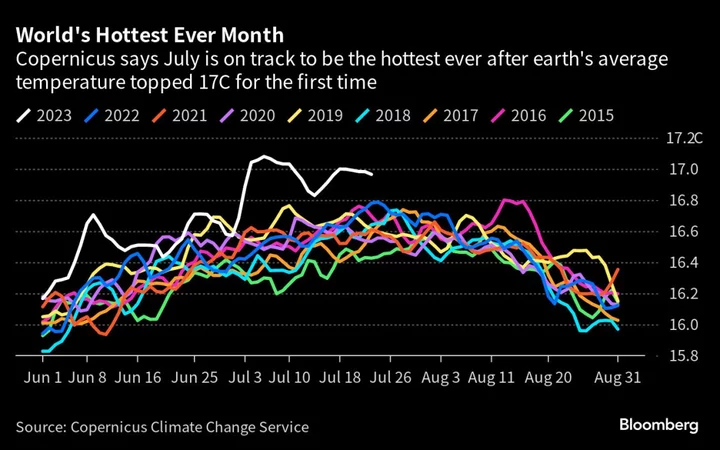The Mediterranean is set to be hit by more record-breaking temperatures later this month, after a brief respite from the searing heat and fires of July.
Much of mainland Europe will be wet and windy in August, with temperatures below the norm. However, the second half of the month will see the return of above-average heat to Spain, southern Italy and Greece, bringing the potential for all-time highs, according to forecasters surveyed by Bloomberg. Rome and Catalonia notched record temperatures last month, while Sardinia matched the European high for July of 48C (118.4F). That could yet be topped.
“August is the warmest month of the year for both land and Northern Hemisphere ocean temperatures, so there is a possibility we will see further heat waves in August,” said Samantha Burgess, deputy director of the Copernicus Climate Change Service at the European Centre for Medium Range Weather Forecasts.
Heat waves seared the Northern Hemisphere this summer, putting the world on track for its hottest ever month in July, after a record June. Fossil fuel emissions are warming the planet, triggering extreme weather from flooding in India and the US to wildfires in Greece and Canada. That’s threatening the health and livelihoods of millions, while some leaders push back against tougher action on climate change.
For the moment, the sharp divide in Europe will remain, with northern regions including the UK, Germany, most of France and the Nordic countries experiencing cooler-than-usual temperatures.
That will provide relief for farmers. Rains throughout early August will aid corn and oilseeds across Europe, with only a small stretch in the south still under stress from adverse weather, Commodity Weather Group said in a note. It will also boost soil moisture levels, aiding sugar beets’ development.
Still, that may not be enough to fully offset the damage from heat and dryness earlier this summer, with the European Union’s crop-monitoring unit projecting sunflower and spring-barley yields to trail the five-year average.
Germany is set to get above average rainfall this month, easing the strain on the Rhine, but even small changes can have a major impact on the key waterway.
Read More: Europe’s Most Important Trade Route Is at Risk as Waters Drop
The cool forecast for the UK remains in place, although there’s a chance of more settled conditions toward the end of the month, according to the Met Office.
“There isn’t a strong signal for heat in the UK, but the door remains open to a spell in the latter half of August,” said Grahame Madge, a Met Office climate change spokesperson.
For other forecasters, the uncertainty in the models suggests that summer heat is over for northern regions.
“Summer heat across Ireland to the Baltic States to northern France and Poland is basically shut off for the year,” Tyler Roys, senior meteorologist and lead European forecaster at AccuWeather.
The wildfires that ravaged the Mediterranean have largely been brought under control, but only after an area almost the size of Greater London was burnt since July 15. Drier-than-usual conditions will continue in parts of Greece and Spain, keeping the risk of wildfires high.
The potential for tropical storms to interact with the Atlantic jet-stream will create both uncertainty and the risk of above-normal heat as the month unfolds.
Read More: Greece Fights Wildfires as Wind Raises Risk Across Mediterranean
“Across the rest of Europe through August, we are forecasting cooler, wetter, windier and cloudier conditions across much of the mainland, with above normal temperatures restricted to Iberia, southern Italy and south-eastern Europe, Amy Hodgson, head of Europe meteorological operations at Atmospheric G2. “There is the potential for further extreme heat and records here.”
--With assistance from Mumbi Gitau and Lars Mucklejohn.









